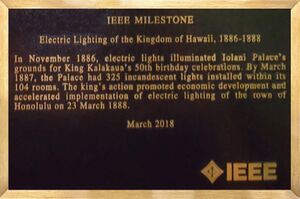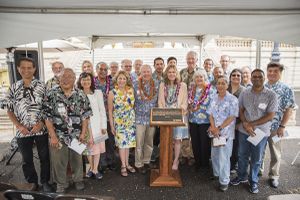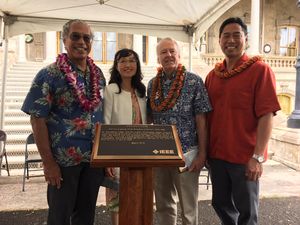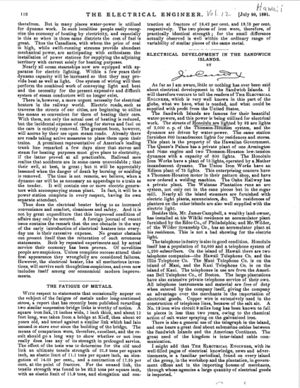Milestones:Electric Lighting Of The Kingdom of Hawaii 1886-1888
Title
Electric Lighting of the Kingdom of Hawaii, 1886-1888
Citation
In November 1886, electric lights illuminated Iolani Palace's grounds for King Kalakaua's 50th birthday celebrations. By March 1887, the Palace had 325 incandescent lights installed within its 104 rooms. The king's action promoted economic development and accelerated implementation of electric lighting of the town of Honolulu on 23 March 1888.
Street address(es) and GPS coordinates of the Milestone Plaque Sites
364 S. King St., Honolulu, HI 96813 USA (21.307509, -157.85899)
Details of the physical location of the plaque
On a wooden stand in the Hale Koa Gift Shop inside the Iolani Barracks (aka Hale Koa: "House of the Warriors") building, which is just north of the Iolani Palace.
How the plaque site is protected/secured
The Iolani Barracks is open to the public Tuesday through Saturday, 8:30am-4:30pm, and is secured otherwise. Further information is at www.iolanipalace.org and 808.522.0832.
Historical significance of the work
A king's foresight and achievement, one who was fascinated with technology in the world stage, traveled thousands of nautical miles to visit the International Exposition of Electricity in Paris as part of his World Tours on 15 August 1881, then met with Thomas Edison the inventor of the light bulb in New York City on 26 September 1881 only 2 years after the invention, spent his own funds for the electric lighting project at Iolani Palace, resulted in 325 incandescent lights illuminating the interior of the Iolani Palace in early June of 1887--four years before the White House had electric lighting. The Town of Honolulu was lighted by electric lights on 23 March 1888. The king's action inspired the technical industry and accelerated implementation of the new technology in the Kingdom of Hawaii then and the State of Hawaii today. This award acknowledges King Kalakaua's foresight and achievement in bringing electric lighting to Hawaii.
Obstacles (technical, political, geographic) that needed to be overcome
Geographic challenge was a major issue for the isolated Kingdom of Hawaii in the Pacific, more than 2,556 nautical miles from the west coast and another 2,600 nautical miles between coast to coast on the mainland. Further constraints included delivery time, longer duration for shipping of materials & supplies, import of skilled laborers and technical personnel, plus long-distance communications between Hawaii and New York. Hawaii is separated from the east coast through 5 different time zones.
KHON2 Television news video clip about the milestone
Features that set this work apart from similar achievements
A king's pioneer work in bringing electric lighting to Iolani Palace in early June 0f 1887 and to the Kingdom of Hawaii 4 years ahead of the White House. This also created Hawaiian Electric Company. Iolani Palace is the only royal residence and Palace in the United States and a registered National Historic Landmark. When the Milestone Award is approved, IEEE can open doors for a world renown historic landmark to educate the general public, international visitors and world-wide audience how Hawaii championed Electric Lighting years ahead of many other cities outside the Northeastern part of the United States.
Significant references
Chronological Events:
26/09/1881 – The Sun article, “Kalakaua visits Edison,” describes King Kalakaua visit to Thomas Edison’s headquarters in 5th Avenue, New York to investigate electric lights to replace kerosene light in Honolulu. The king was undecided between gas or electric lights but resolved to wait until electricity has had a full and practical trial. [1-King visit Edison]
22/07/1886 – The Daily Bulletin article, “Electric Light,” states that five lights were provided at various locations near the palace grounds demonstration. [2-Iolani light demo]
18/09/1886 – The Daily Bulletin article, “The Legislature,” describes changes to the legislature's electric light bill from “C.O. Berger & Associates” (Brush Electric) to the “Ministry of Interior is hereby authorized to grant unto any person, associations of persons, or corporation the right” to maintain electric works and to light the City of Honolulu with electric lights. Changes required to avoid additional charges due to patent infringements from [Thomson-Houston]. [3-Seq-4 charlesberger]
19/11/1886 – The Daily Bulletin article, “The Electric Light,” reports that ten arc lights of 2000 candle power each arrived Wednesday by steamer. Electrician D.P. Smith and assistant A.W. Smith were to install the lights. [4-seq 3 palace lighting]
26/11/1886 – The Daily Bulletin Article “The Jubilee Ball” The Jubilee Ball 8pm to 11 or 12am featured electric lights at the entrance to and exit from the Palace grounds, making the streets at the outside of the enclosure as well as drives and walks inside almost as light as day. [5-Jubilee lights]
03/12/1886 – The Daily Herald article, “Coming to the Light,” discusses the Legislature's actions and states that “There are not at the present time a single city of any size lighted entirely by electricity”. [11-seq-2 herald 18861203]
08/02/1888 - The Pacific Commercial Advertiser article, “The Electric Light,” W.O. Faulkner states that two circuit are being installed – one for arc lights and the other incandescent lamps. Standard light being 2,000 candle power. Dynamos to be run on water power, with 7-10 horse power (hp) required for each 2,000 candle power lamp. [8-seq2 adv 18880208]
21/03/1888 – The Daily Bulletin article, “Honolulu Electric Works,” describes the energized dynamos after receiving turbine wheels manufactured by Leffel & Co., Springfield Ohio, under 135 psi. The armatures turn at about 900 revolutions per minute (rpm). Dynamos and lamps were supplied by Thomson-Houston Co. of Massachusetts [which eventually became General Electric]. The larger dynamo, “Harry,” supplies power to 50 arc lights and a smaller eight-year-old dynamo, “Billy,” supplies power to twelve arc lights hung around the room. There were twelve older lamps showing corrosion. [6-Honolulu Electric Works]
24/03/1888 – The Daily Bulletin article, “Electric Lighting of Honolulu,” Energized two circuits run by a large and small dynamo at the electric light station [hydroelectric plant] in the [Nuuanu] Valley. The long circuit is fifteen miles and the short one is six miles on 46 poles. [7-seq – 3 nuuanu hydroelectric]
26/03/1888 – The Pacific Commercial Advertiser article, “A New Danger,” reports that an accident occurred when wires contacted a tree. Another article, “The Electric Lights,” reports that there are two circuits, one fifteen miles and other six miles. The dynamos are run by water and pressure at the water wheel is 130 pounds per square inch (psi). The lamps are 2,000 candle power each. [9-seq2- 2 adv 18880326]
01/08/1888 – The Pacific Commercial Advertiser article, “The Legislative Assembly,” under the “Afternoon” Report of Committee, Appropriation, reports on a bill to provide additions to the Honolulu electric light system for $43,000. It reports of the existing system, “The power for running the electrical works is obtained from the water pipe that supplies the town of Honolulu with water. A turbine wheel is used to run the dynamos. The water passes on from the wheel into another large pipe through which it is conducted on down the valley for distribution through the town. The present system cost up to March 31, 1888 $42,746.45 and the running expense is about $8,000.” It is proposed to ask for the additional appropriation to purchase and erect one more 50 arc light dynamo, in order to complete the system for lighting the streets of Honolulu, as well as two incandescent dynamos to furnish lights for the town's residences. The cost of additional dynamos for street arc lights will be about $13,913 and additional expense for running the same will be $1,080. The cost of the two additional incandescent light dynamos will be about $28,441 and the additional expense of running the same $1,700. The total receipts from the incandescent lights are estimated at $12,750. The article states, “At present there is not a sufficient water supply during the summer to furnish the necessary power to run the additional dynamos; but by constructing storage reservoirs above the electric works, which is really necessary in order to meet the increasing demands for water in Honolulu, sufficient power can be readily obtained.” [10-seq 2 adv 18880801]
Supporting materials
Eleven (11) References and a Letter of Agreement were emailed to ieee-history@ieee.org, Attention: Milestone Administrator on this day of 22nd of August 2017. Letter signed by Site Owner, Iolani Palace, on 10 August 2017 was emailed to ieee-history@ieee.org, Attention: Milestone Administrator on this day 17th of August 2017. Copyrighted 2017, Hawaii News Now, "Iolani palace gets new nighttime look from over 1,000 LED lights", 28 August 2017.



